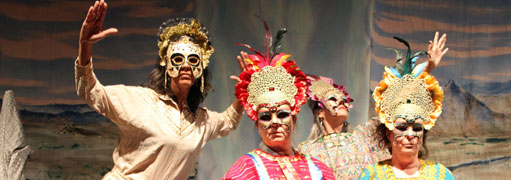For 20 years, the stories of women and girls killed in Ciudad Juárez have been silenced in their own country and largely ignored by the world. A wave of roughly 60 femicides in 2012 is receiving even less media attention as the untold number of deaths continues to grow. In Río de Lágrimas ( River of Tears ), a multilingual music and storytelling performance at the National Hispanic Cultural Center, the women of Albuquerque-based collective Las Meganenas nobly attempt to tell the victims’ stories. The piece hinges upon the legend of Hernando Cortés’ doomed lover, La Malinche—who later, according to Lágrimas’ construction, became La Llorona. Most of us, at some point or another, were scared pantsless by the thought of her spirit wandering the river at night, wailing and searching for her lost children. The legends of Llorona and Malinche speak to relationships between men and women, oppressors and oppressed, conquistadors and native people. Lágrimas draws parallels between the imperialism that drove Malinche to her tragic fate, and the maquiladoras , or factories, where many of the abducted women and girls from Juárez have worked—dangerous jobs created by the North American Free Trade Agreement that draw the poor and defenseless to a murder zone.The foundation for Lágrimas’ narrative is a young woman—a student, presumably—who falls asleep while reading about NAFTA. She’s subsequently visited by five Nahuatl spirits: El Cuento, El Viento, La Musica, El Alma and La Muerte. The spirits guide the woman on a journey through history, transforming her first into La Llorona and later into one of the murdered maquiladora workers. Unfortunately, we learn very little about the young woman who is supposed to be our portal into the story: “I’ve got to go—I have to read this book about the consequences of NAFTA,” is her first and only line. As a result, the politically charged sequence that follows is too jarring, and the woman herself, who never reappears, feels more like a device than a part of the story. The comparisons Lágrimas makes between the conquered indigenous people of Mexico and the present-day factory women are clear and compelling. The argument loses steam, though, when it comes to the connection between NAFTA and the murders. Lágrimas gives little information about the agreement, or specifically how it has affected working conditions in Mexico. The audience is left to connect the dots instead of being given supporting facts—which the production is seeded with elsewhere in abundance.Despite the rocky opening, Lágrimas gains momentum as the spirits introduce us to La Malinche-cum-La Llorona, and the real adventure begins. The spirit of El Cuento is cast fittingly for Soledad Hindi, Lágrimas’ playwright. She tells of how the poor indígena fell in love with the conquistador Cortés, only to later fall victim to his betrayal. How, after using her to launch an attack on her people, Cortés abandoned the girl to marry a European woman, leaving her alone with her shame and the illegitimate children she bore him. And how finally, in a fit of sorrow and madness, she drowned her children in the river and then herself, becoming La Llorona.From here, the spirits take us on a series of journeys, jumping across space and time. In these passages, punctuated by powerful musical interludes performed live onstage by the company, Lágrimas hits its stride.Music is a central element in Lágrimas : Corridos and other ballads and traditional folk songs course through the production. Each one is beautiful, polished and well-placed, underscoring the emotional core of the moment. While the score is the highlight of the production, almost all of the stylistic elements are striking. From the backdrop featuring a symbolically outsized river that doubles as a projector, to the terrifying papier-mâché mask of La Llorona frozen midwail, the design evokes a connection to Mexican and Southwestern tradition, spirituality and folklore. The linguistic elements triumph too, as English, Spanish and Nahuatl are woven together effortlessly and effectively. The strengths of the production, however, make its shortcomings stand out sharply. The performers’ movements in particular feel awkward and directionless, as though the actors are crammed into a too-small place they don’t quite know what to do with. A shame, because the few instances in which the actors’ physical life actually does rise up to match the power and precision of their musicianship are Lágrimas’ most powerful points. In one such instance, El Cuento holds a slaughtered maquiladora woman in her arms, then flings the body around like a rag doll.In this riveting display, it becomes clear that El Cuento is the true backbone of the piece. The heart of the story is not the student’s dream-journey, nor La Llorona’s victimization, nor even the brutalization of the Juárez women and girls. It’s El Cuento’s desperate desire to tell the story and to be heard. Unfortunately, until this moment, the spirits are largely indistinguishable from one another. Had these characters been developed sooner and with greater depth, the entire piece would have soared to a higher level. Río de Lágrimas is intelligent and articulate but could be more powerful if it filled in some narrative and choreographic gaps. Still, it’s a deeply ambitious undertaking, and it’s impressive how much it accomplishes—an utterly worthwhile production. The women of Las Meganenas have worked doggedly to give back to the women of Juárez what has been violently taken from them: their voice. We would be wise to listen.
Río de Lágrimas Friday, June 29, 8 p.m.Saturday, June 30, 8 p.m.Sunday, July 1, 2 p.m.
National Hispanic Cultural Center, Wells Fargo Auditorium 1701 Fourth Street SW Tickets: $15724-4771, nhccnm.org













